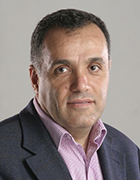How IoT, Medical Devices and Wireless Power Will Transform Patient Care for Doctors and Healthcare Providers

Many medical devices today rely on rechargeable lithium-ion batteries. These batteries offer some big advantages: They’re small and lightweight, and they last a long time. Smaller, lighter medical devices are not as difficult for patients to wear or carry with them, and they’re more discrete, which likely improves patient adherence. For example, a heart rate monitor that a patient has to wear stuck to his chest for 7 to 14 days before mailing it back to the lab is much more likely to stay put when the patient hardly notices it is there.
To help diagnose and manage symptoms, increase patient independence, and improve quality of life, doctors and healthcare providers rely on wireless, battery-operated devices such as continuous glucose monitoring (CGM), wearables for incontinence, fitness and heart rate tracking (ECG), and blood pressure monitors and biosensors.
The problem is the batteries in these devices have limitations. They can deplete prematurely. They need to be charged. And they can release heat and toxins. What’s more, evaluating the data from each of these devices independently of each other is missing a bigger potential for healthcare advancements.
Wireless Power: Reliable, Continuous Power for Wearable Medical Devices and Biosensors
A more viable solution to powering small wearable medical devices is wireless power over air. Wireless power technology, such as radio-frequency-based wireless “battery-free” power at a distance, solves all of the challenges that batteries present, while offering additional benefits to patients and their healthcare providers.
| Batteries | RF-Based Wireless Power over Air |
| Limited lifespan, needs replacement | Unlimited lifespan, no replacements required |
| Requires downtime to charge | Always on |
| Environmental hazards | No impact to environment |
| Small design | Smaller design |
| Requires additional technology to connect with Bluetooth or Wi-Fi | Connectivity built in |
| Potentially unsafe toxin exposure | Inherently safe for human use |
Most medical device manufacturers are already focused on human-centric design. When empowered with a technology that is inherently safe for human use, they will have additional leeway to create more innovative products: Products that are smaller, less intrusive, and can include sensors and connectivity that provides medical providers a more complete picture of health status. Even the smallest of feature advancements in a device can make a huge difference in the lives of patients.
Consider the patient who wears hearing aids. Most hearing aids must be removed to charge. For the patient, timing is everything; if the hearing aids’ power supply depletes at the wrong time, this could impact the individual’s work, safety and quality of life. Wireless power would eliminate the need to remember to charge at a convenient time, because charging would not be necessary; the devices would always be powered up and at the ready.
An always-on hearing aid might be considered more on the “convenience” side of benefits of wireless power. However, when you consider devices such as biosensors, continuous glucose monitoring, and untethered insulin delivery systems, patients’ lives are at stake. With wireless power providing a continuous and uninterrupted source of energy, our healthcare system would have more failsafe medical devices.
Wireless Power Provides Doctors with Real-Time Health Alerts through Remote Patient Monitoring
Patients in a hospital bed are connected by wires and beeping machinery to keep healthcare workers aware of their heart rate, blood pressure and other vitals. But what about the patient at home? RF-based wireless power enables doctors and their staff, as well as their patients, with their permission, to be instantly alerted when sensor readings become dangerous or out of the norm, without any additional technology required, no matter where they are—at home, during transportation, or while getting tests in another part of the hospital.
Wireless power not only empowers always-on, continuous monitoring, but also the ability to make quick, life-saving decisions in real time.
Now imagine not only single devices that are wirelessly powered, but also “smart, connected devices, such as a [whole] home health-monitoring system that includes a data processing center that allows physicians to remotely monitor their patients’ devices and clinical status.”1
Wireless power decreases the barriers that medical device manufacturers currently are up against in creating such connected systems. Devices powered with RF-based wireless power could be designed to also communicate with each other and potentially trigger events, creating a network benefit effect.
Sensors in IoT Devices Allow Healthcare Providers to Extend Reach Outside of Traditional Clinical Settings
Wirelessly powered wearable medical devices and biosensors will enable doctors to keep tabs on patients who are going about their lives outside of a clinical setting but need a level of healthcare monitoring for accurate diagnosis or effective disease management.
RF-based wireless power will enable medical device manufacturers to create entire wearable healthcare monitoring systems without the limitations of wires or batteries, and with a direct focus on patient comfort, adherence and quality of life.
Reference
- Porter, M.E. and Heppelmann, J.E. (November 2014). “How Smart, Connected Products Are Transforming Competition”. Harvard Business Review.